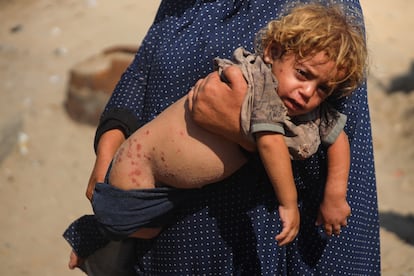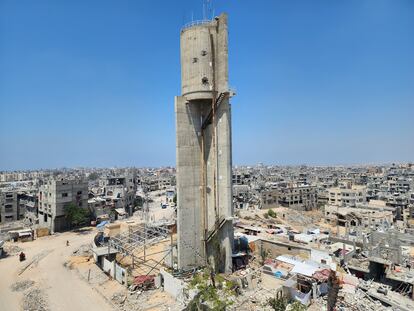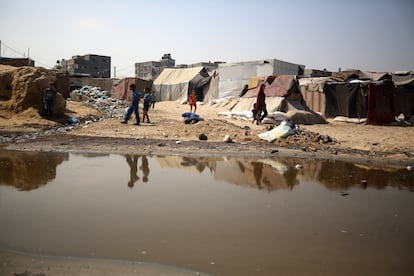Polio, hepatitis, meningitis: Gaza’s humanitarian disaster takes the form of disease
The discovery of polio in a baby born at the beginning of the war marks the first case of the virus in the Strip in 25 years, a sign of the impacts of overcrowding, water shortage, malnutrition, and forced displacement

United Nations agencies and non-profits have been issuing warnings about the possibility for months. Some saw it as just a matter of time. Disastrous health conditions, vast numbers of people living in tents, serial displacements and food and water shortages were bound to wind up translating, sooner or later, into disease. Primarily, into those that flourish in overcrowding or from fecal matter in the water supply. Last week, health authorities announced the first case of polio in Gaza in 25 years, in Deir al-Balah, a town where tens of thousands of displaced people have wound up. The patient is a 10-month-old baby who was never vaccinated. It’s no coincidence that the youngster’s time on this earth exactly coincides with the invasion of Gaza, where vaccination rates have dropped from 99% to 89% and during which at least 50,000 babies have been born who — amid bombs and forced evacuations — have seldom received their vaccines.
Polio is primarily transmitted through the consumption of water with fecal matter. The virus was detected in July, in water samples from six points in Khan Younis and Deir al-Balah. To confirm the suspected cases, the samples were brought to Jordan for analysis.
Last week, the World Health Organization (WHO) and UNICEF announced in a joint statement that they have guaranteed the supply of 1.6 million doses of type 2 oral vaccine to supply more than 640,000 children under the age of 10, but that the campaign will only be effective if it reaches at least 96% of them, which “will be impossible” without a “humanitarian pause”.
The vaccines would enter at the end of August through Ben Gurion Airport near Tel Aviv, and must make their way to Gaza in temperature-controlled storage. Funding will be required to cover travel expenses, fuel, and operational telecommunications networks to inform the population of the vaccine campaign.
For the 640,000 Gazans under the age of 10 who are condemned to remain in the hellish current conditions of their homeland, the future very much depends on those who are involved in ceasefire negotiations, individuals who are often inhabiting completely different worlds, thousands of miles away.
That dialogue is at an impasse due to the failed strategy of one of the mediating countries’ chief diplomats, the United States’ Antony Blinken, who allowed Israeli Prime Minister Benjamin Netanyahu to modify the agreement, presented a new draft they dubbed a “compromise proposal,” and pressured Hamas to accept its terms. The goal remains to hold the meeting originally scheduled to take place on August 22 this weekend. President Joe Biden (with Democratic presidential candidate Kamala Harris on the call) spoke late Wednesday with Netanyahu to convey the “urgency of closing” a ceasefire agreement.

Humanitarian pause
For the White House, that “urgency” stems more than anything from impending presidential elections against Donald Trump and the risk of war spreading across the region, if negotiations fail. But for humanitarian organizations it has more to do with avoiding the outbreak of polio, which primarily affects children under the age of five, can cause paralysis and deformities, and which widespread vaccines nearly completely eradicated from the world four decades ago.
Health advocates are now focused on achieving a one-week humanitarian pause to carry out vaccinations. Such a plan was called for last week by UN Secretary General António Guterres himself, and was supported by the Hamas government’s health ministry in Gaza. Israel has not formally responded and COGAT (the unit of Israel’s defense ministry that is responsible for coordinating civilian issues in Gaza and the West Bank) commented only by noting that it has coordinated the entry of more than 300,000 vaccines, and that more than 90% of Gazans are vaccinated.
Blinken raised the issue with Netanyahu at a meeting, but the diplomat’s vague comments on the subject at a Tel Aviv press conference on Monday did not allow much room for hope. “We very much share the concern about the possibility of [polio’s] reemergence, and we have been working on a detailed plan to make sure that those who need to be vaccinated against it can be vaccinated. We are working on that with the Israeli government and I think we will be able to move forward with a plan to do that in the coming weeks,” Blinken said.
The prospect of weeks of planning runs contrary to the plan proposed by humanitarian groups. “Now that polio is confirmed, the response must be measured in hours, not weeks,” said Natalia Anguera, head of Action Against Hunger for the Middle East, in an appeal issued Tuesday by some 40 medical professionals and NGOs such as the Norwegian Refugee Council, CAR, and Oxfam.
Water with feces and mountains of garbage
The solution must not be limited to the opening of another dubious “humanitarian corridor,” given the interconnectedness of a territory where the population’s priority is to find food and water and where puddles of water contaminated by fecal matter and mountains of garbage have become the new daily reality: 70% of sewage pumps have been destroyed and not a single sewage treatment center is in regular operation.
Many Gazans are using holes in the sand as latrines. Water for washing one’s hands after using such facilities is collected in unsanitary gas cans that residents carry back and forth. The UN estimated that during the first seven months of the war, some 415,766 individuals, a quarter of them children under five years of age, suffered from acute diarrhea. With many living in overcrowded tents on the sand in sweltering heat, cases of scabies, lice, rashes, chicken pox, and acute jaundice have also impacted tens of thousands of people.
On August 12, the UN World Food Program reported that many community kitchens in central and southern Gaza are facing difficulties due to the instability of humanitarian supplies and the lack of food and fuel, especially as a result of the latest evacuation orders, which were previously subject to international condemnation but are today part of daily life for Gazans. There have been 12 such orders in August, one every two days, which have affected some 250,000 people, more than a tenth of the population. The latest evacuation orders impacted Khan Younis and Dier al-Balah, where some families have spent the night on the road or on the beach after fleeing the advance of tanks from the east and west. Ninety percent of Gazans have been displaced since the beginning of the war, and most live in subhuman conditions in tents or crammed into apartments, some damaged by bombs.
Sofía Piñeiro has been to Gaza on two occasions as Doctors Without Borders Spain’s nurse activity manager. During her first trip in February and March, her mission centered on Rafah, which had not yet been invaded. Her second trip, during which she worked in the pediatric and maternity section of Khan Younis’ Al Nasser Hospital, ended last week. The environment, she says, is “very different.” “Before there was the urgency of the refugees, but Rafah was considered a safe zone. The war was further away. That boundary has been completely blurred,” she says by telephone. The Israeli army recently reduced the so-called “humanitarian zone” to 11% of Gaza.
On her latest trip, Piñeiro encountered the usual: simple wounds that wound up getting infected and requiring antibiotics (due to a lack of water and material needed to perform basic cleaning), respiratory and skin infections, and insect bites. But she says there is also “a level of overflow” that makes the necessary isolation to prevent the spread of hepatitis A impossible. The disease has already impacted 100,000 Gazans, according to UN data.
“At a 60-bed hospital, we had up to 180 patients … In a room for four children, seven. We had four-month-old babies with fever in the hallway because we don’t have anywhere else to attend to them,” she says. “Post-partum women ask to be released. They don’t feel safe in the hospital, because some have been the target of attacks.”

It’s a vicious cycle. Meningitis, for example, is transmitted through saliva, like Covid, which is why patient isolation is crucial, as well as a prescribed diet. As primary care providers cannot cover their needs, some patients go directly to already over-extended hospitals, where health workers face the dilemma of treating affected individuals and sending them back to living in a tent with up to 14 other people. These difficulties are exacerbated by complicated and dangerous conditions that are involved in arriving at health care facilities (for both patients and health professionals) and the fact that Gazans rarely manage to stay long in one place.
After 10 months of war, there have also been considerable cumulative effects. Bodies pay the price for living for so long under such precarious conditions. Children, Piñeiro explains, “have fewer defenses after 10 months of a very basic, carbohydrate-based diet.” Israeli Finance Minister Bezalel Smotrich noted earlier this month that starving “two million people” (referring to the total number of people living in the Strip) “might be just and moral until the Israeli hostages” held by Hamas are returned, but that “no one” in the world would allow such a tactic. “We bring [allow in] aid because we have no choice … We need international legitimacy for this war,” he added.
The Israeli army has vaccinated its soldiers, following the discovery of polio in the water samples. That campaign has taken place in Israeli territory, for both those on leave from being stationed in Gaza and those who will soon arrive there. That does not solve, however, the risk that autumn rains will carry contaminated water to an aquifer that supplies Israel, Egypt, and Jordan.
Sign up for our weekly newsletter to get more English-language news coverage from EL PAÍS USA Edition
Tu suscripción se está usando en otro dispositivo
¿Quieres añadir otro usuario a tu suscripción?
Si continúas leyendo en este dispositivo, no se podrá leer en el otro.
FlechaTu suscripción se está usando en otro dispositivo y solo puedes acceder a EL PAÍS desde un dispositivo a la vez.
Si quieres compartir tu cuenta, cambia tu suscripción a la modalidad Premium, así podrás añadir otro usuario. Cada uno accederá con su propia cuenta de email, lo que os permitirá personalizar vuestra experiencia en EL PAÍS.
¿Tienes una suscripción de empresa? Accede aquí para contratar más cuentas.
En el caso de no saber quién está usando tu cuenta, te recomendamos cambiar tu contraseña aquí.
Si decides continuar compartiendo tu cuenta, este mensaje se mostrará en tu dispositivo y en el de la otra persona que está usando tu cuenta de forma indefinida, afectando a tu experiencia de lectura. Puedes consultar aquí los términos y condiciones de la suscripción digital.
More information
Archived In
Últimas noticias
Maduro pleads not guilty before the federal court in New York: ‘I am still the president of Venezuela’
A new test can detect Alzheimer’s from a finger prick
UN team enters Sudanese city of El Fasher after paramilitary massacre: ‘It’s like a ghost town’
A recipe for resistance: Indigenous peoples politicize their struggles from the kitchen
Most viewed
- Gilles Lipovetsky: ‘If you want to live better and fall in love, take Prozac, don’t look to philosophy’
- Alain Aspect, Nobel laureate in physics: ‘Einstein was so smart that he would have had to recognize quantum entanglement’
- Alvin Hellerstein, a 92-year-old judge appointed by Bill Clinton, to preside over Maduro’s trial in New York
- Why oil has been at the center of Venezuela-US conflicts for decades
- Maduro’s downfall puts China’s relationship with Venezuela to the test











































